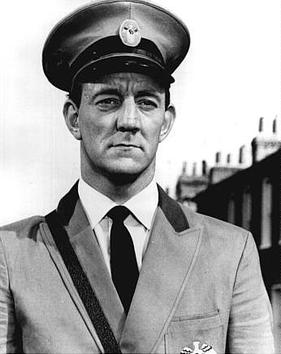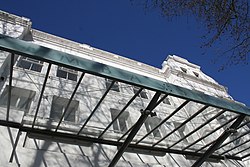Cecil Antonio Richardson was an English theatre and film director and producer whose career spanned five decades. In 1964, he won the Academy Award for Best Director for the film Tom Jones.

The Noël Coward Theatre, formerly known as the Albery Theatre, is a West End theatre in St. Martin's Lane in the City of Westminster, London. It opened on 12 March 1903 as the New Theatre and was built by Sir Charles Wyndham behind Wyndham's Theatre which was completed in 1899. The building was designed by the architect W. G. R. Sprague with an exterior in the classical style and an interior in the Rococo style.

The Gielgud Theatre is a West End theatre, located on Shaftesbury Avenue, at the corner of Rupert Street, in the City of Westminster, London. The house currently has 986 seats on three levels.

The Theatre Royal Haymarket is a West End theatre on Haymarket in the City of Westminster which dates back to 1720, making it the third-oldest London playhouse still in use. Samuel Foote acquired the lease in 1747, and in 1766 he gained a royal patent to play legitimate drama in the summer months. The original building was a little further north in the same street. It has been at its current location since 1821, when it was redesigned by John Nash. It is a Grade I listed building, with a seating capacity of 888. The freehold of the theatre is owned by the Crown Estate.
Margaret Scudamore was an English theatre and film actress who began in ingenue roles before achieving a prolonged career in stage and screen support roles. She and her first husband, Roy Redgrave (1873-1922), are considered to be the first members of the now renowned Redgrave acting dynasty.

George Alexander Coulouris was an English film and stage actor.

Bryan Pringle was an English character actor who appeared for several decades in television, film and theatre productions.
Francis Martin Sewell Stokes was an English novelist, biographer, playwright, screenwriter, broadcaster and prison visitor. He collaborated on a number of occasions with his brother, Leslie Stokes, an actor and later in life a BBC radio producer, with whom he shared a flat for many years overlooking the British Museum.

My Fat Friend is a play by Charles Laurence.

Jane Baxter was a British actress. Her stage career spanned half a century, and she appeared in a number of films and in television.

Margaret Rawlings, Lady Barlow was an English stage actress, born in Osaka, Japan, daughter of the Rev. George William Rawlings and his wife Lilian Rawlings.
André van Gyseghem was an English actor and theatre director who also appeared in many British television programmes.
The Hull Repertory Theatre Company was a theatre company in Kingston upon Hull, East Riding of Yorkshire, England. It was founded in 1924 by Arthur Whatmore. In the 1930s it was managed by Pepino Santangelo who developed it and it became the Hull New Theatre in 1939.

Phyllis Edith Mary Blythe, known professionally as Jenny Laird, was a British stage, film and television actress.
Gerald Douglas Savory was an English writer and television producer specialising in comedies.

John Hickson Warner was a British film, television and stage actor whose career spanned more than five decades. His most famous role was that of Timothy Dawes in Salad Days, which premiered in the UK at the Theatre Royal in 1954, and transferred to the Vaudeville Theatre in London in the same year.

Jean Forbes-Robertson was an English actress. A versatile Shakespearean actress, she was often cast in boys' roles because of her slim build, playing Jim Hawkins in a stage version of Treasure Island, Puck in A Midsummer Night's Dream and, most famously, the title role in Peter Pan.

The Complaisant Lover is a 1959 comedy play by Graham Greene. Consisting of two acts, each of two scenes, the play revolves around an affair between Mary Rhodes and Clive Root, the book seller friend of her husband, Victor. The play takes place in the Rhodes family home and an Amsterdam guesthouse.
Daisy Fisher, born Daisy Gertrude Fisher; was an English novelist and playwright. She was the writer of several romantic novels, a lyricist, scriptwriter, actress and singer. In the 1920s she wrote the lyrics for some of Eric Coates' compositions. In 1926 she published her first book Lavender Ladies A Comedy in Three Acts followed by more in the 1930s. Fisher authored some plays with the song writer Harold Simpson, Ronald Jeans and Clifford Seyler. She was the wife of Herbert Mason the film director and producer who previously acted on stage. After the Second World War they worked together on some plays.

William Armstrong, CBE was a British actor, theatre manager and director, associated for many years with the Liverpool Playhouse, where as director he was an important influence on young actors in his company, including, at various times, Robert Donat, Robert Flemyng, Rex Harrison, Michael Redgrave and Diana Wynyard.














